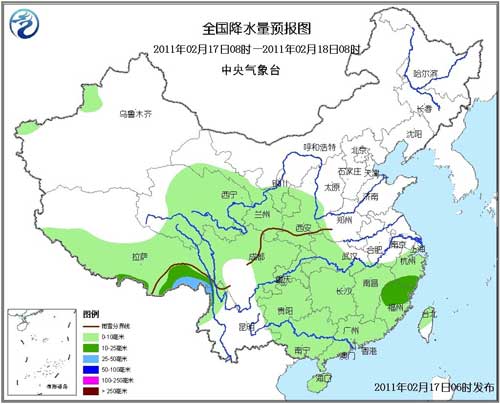Gansu is now raining in the snow, and fertilizing in the snow can effectively strengthen the seedlings.
Since October 2010, there has been virtually no effective precipitation in most parts of Gansu, and severe drought has occurred in large areas throughout the province. Due to drought, 750,000 people and 600,000 head animals have difficulty drinking water to varying degrees, and the drought-affected area of ​​crops has reached 3.6 million mu. At present, all departments in Gansu Province are actively fighting drought, and have used the drought-resistant experience summarized in the long-term production practice in the arid regions to promote drought-resistant springs and spring ploughing and have made certain achievements.
Long-term drought in southern Fujian and Tianshui
According to the drought monitoring of the winter wheat wintering area in Gansu Province on February 13th, there are currently 3-5 cm dry soil layers in most parts of Hedong, Gansu Province. Since most winter winter crops have not yet returned to green, drought has little impact on agriculture. However, most of the southwestern part of Weinan City and Tianshui City, Qinzhou and other places have poor soil moisture; among them, Wuduchuanba Banshan dry land, Lixian County, Wenxian County, Qin'an, Qinzhou, Zhouqu and other shallow soils The relative humidity is more than 40%, there is moderate to heavy drought, and winter wheat appears in some parts of Qinzhou District of Tianshui City.
Today and tomorrow, rain and snow come to Hedong to ease the drought

National precipitation forecast map
It is estimated that on the 17th and 18th, there will be small snow (rain) in most parts of Hedong, and medium to heavy snow in some places. This process can slow down the current development of drought, and it is more favorable for the wintering crops to grow green, but it cannot completely eliminate the drought. The wintering crops in Weinan City and other places have begun to return to green. It is expected that the precipitation will be relatively small, and the drought-proof work will not relax. .
Spring Management Techniques of Winter Wheat in Dryland
Â
Â
Early spring è¶å¢’ top dressing can effectively weaken and strengthen, improve the good growth and drought resistance in the middle and late stages. For weak seedlings, yellow seedlings with de-fertilization symptoms before winter, wheat fields with insufficient application of base fertilizer, and frozen wheat fields, they should be topdressed as soon as possible, with nitrogen fertilizer as the mainstay. In particular, there are still snow-covered wheat fields, which can be used to melt fertilizers and fertilizers, and fertilizers can be infiltrated into the wheat fields with snow; no ice and snow cover the wheat fields, and the soil can be fertilized in the early spring when the soil returns to the tide or after the rain and snow. In general, weak seedling fields can be applied with urea 5-10 kg/mu; the bottom fertilizer is not applied to the wheat field, the wheat field with few roots and shallow roots, and the middle slope is dry and thin, the root and drought resistance of phosphate fertilizer should be strengthened, and nitrogen and phosphorus should be applied. The application of phosphorus diammonium 7 to 10 kg / mu, urea 5 to 7 kg / mu. This year, the sooner the better, the better, but before the winter, there are already long wheat fields, and there is no need to topdress in early spring.
Gasoline tools can handle the more professional tasks when you are looking for something to tackle heavier jobs
Gasoline Equipment and Special Tools,Gasoline - Outdoor Power Tools,gasoline garden tools
AWLOP CO.,LTD , https://www.awlop.com